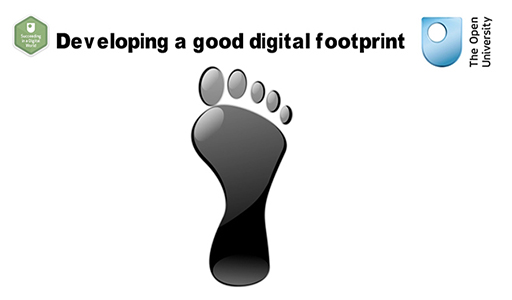2.1 Shaping your digital identity
Once you understand how important your digital footprint is, you can start to think about how you might improve the way in which you come across online. Watch the video about improving your digital footprint.

Transcript
Once you understand how important your digital footprint is, you can start to think about how you might improve the way in which you come across online. So let's see how you can do this. One of the first things you can do is to delete or deactivate all those online accounts that you don't use anymore. Doing this will mean that you won't need to worry about them, they can't be scammed, and it will leave you time to concentrate on the accounts that are most useful to you. There are tools available online that can help you do this.
For the accounts you choose to keep, think about who has access to them and filter out people you don't really know or no longer keep in contact with. For example, Facebook tends to be more personal, so you may only want family and friends to have access to the information you put there. However, if you use LinkedIn, you will want to connect with a professional network and be considered for jobs. If you want to be noticed, your settings should allow greater public access.
However, the information you provide is likely to be professional rather than personal. Now is the time to delete all those photographs that don't show you in a good light. Also, delete any posts that you're not proud of. Social network sites will provide you with information on how to do this. Sites like LinkedIn are great for showcasing your skills and knowledge.
If you want to get noticed, you'll need to ensure that you build up your profile to include your achievements, skills, qualifications, and knowledge. Consider your profile as your online CV. Employers or employment agencies frequently search LinkedIn for people with specific skills. When you think about the words you use on your profile, think about the words for which employers might search in order to find people with your skills.
There are a number of ways you can connect with others in your profession or field of interest. Twitter is a good place to find connections. Being active on Twitter will make it more likely that people will notice you. Stick to professional content and think about what your tweets are saying about you in a professional sense.
Blogs are also a great way of showcasing your knowledge. Think about starting your own professional blog, or find expert blogs that will keep you up to date. Adding your own comments will enable you to be part of the wider discussion. Discussion forums are also good places to meet professionals in your field. They are great places to learn from others and share good practice.
Here some tips about shaping your digital identity.
Top Ten Tips to Improve your Online Presence
- Delete or deactivate old unused accounts. Doing this will mean that you won't need to worry about them, they can't be scammed, and it will leave you time to concentrate on the accounts that are most useful to you. There are tools available online that can help you do this.
- Manage the access to the accounts you keep. Filter out people you don't really know or no longer keep in contact with. For example, Facebook tends to be more personal, so you may only want family and friends to have access to the information you put there.
- Delete photographs that don't show you in a good light.
- Delete posts that you're not proud of, or that no longer reflect your views. Social network sites will provide you with information on how to do this.
- Sites like LinkedIn are great for showcasing your skills and knowledge. If you use LinkedIn, you will want to connect with a professional network and be considered for jobs. You can adjust your settings to allow greater public access.
- Build up your profile to get noticed. Make sure to include your achievements, skills, qualifications, and knowledge.
- Consider your profile as your online CV. Employers or employment agencies frequently search LinkedIn for people with specific skills. Use words on your profile, that match the words employers might search to find people with your skills.
- Use Twitter to connect with others in your fields of interest. Twitter is a good place to find connections. Being active on Twitter will help people will notice you. Stick to professional content and think about what your tweets say about you in a professional sense.
- Start your own professional blog. Blogs are also a great way of showcasing your knowledge, or you could find expert blogs that will keep you up to date. Adding your own comments will enable you to be part of the wider discussion.
- Join discussion forums to meet professionals in your field. They are great places to learn from others and share good practice.
Activity 2 Shaping your digital identity
Make some notes of the steps you might take to reduce any negative impact of your digital footprint and to create a positive digital identity, particularly for career purposes.
- Note one or two things you want to achieve when you’re online, for example, keeping up with friends and family, developing your business, keeping up to date with your interest or study topic.
- In your reflective journal, make a note of three things you can do to develop your footprint and shape your identity.
It is worth thinking about who is shaping your digital footprint and digital identity– is it you or your friends?
Discussion
You may have come up with some of the following:
- build up a profile on LinkedIn
- connect with others in your field of interest through Twitter
- set up a blog
- connect with others through open online study
- check privacy settings on social media sites
- delete old accounts and old social media posts / photographs that don’t show you in the best light
- switch off location/GPS settings on your mobile phone
- ask other people to remove (or not post) photos of you that you don’t wish to be shared
- do not publish your personal and contact details on social media sites or blogs.
It’s possible you have thought of other things too. For example, remember that Google will remove your information if you request it under the ‘
You will have the opportunity to put what you have learned into practice in the next activity. In the meantime, add anything you want to follow up to your reflective journal.
In the next section, you will explore what is meant by digital citizenship and how you can contribute positively online.
2 Openness versus privacy
